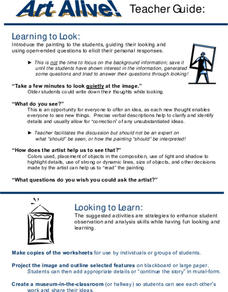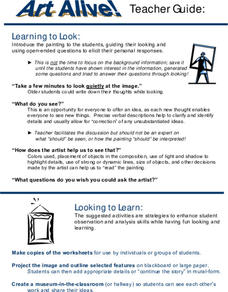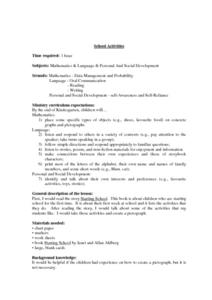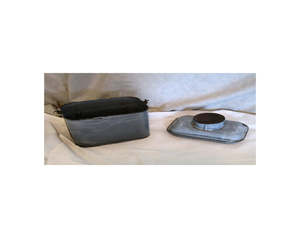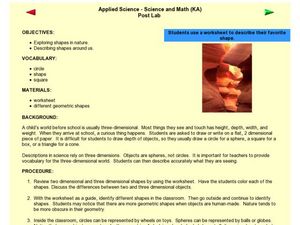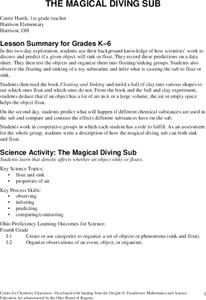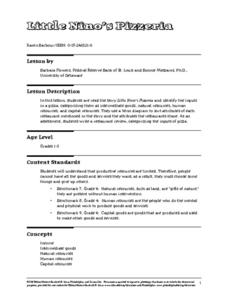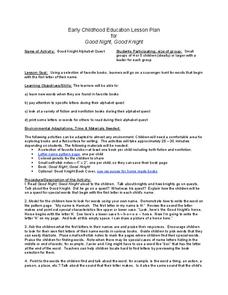Curated OER
Digging Up Dinosaurs
Learners research dinosaurs using text, software, and Internet resources while role playing as paleontologists. They place the information from their research in databases and publish an illustrated page about their findings.
Memorial Art Gallery
Art Alive! - Towing a Boat, Honfleur
Color, light and shadow, the placement and size of objects. These are some of the tools artists used to tell their stories. Model for learners how to read a painting by closely examining these features. The richly detailed packet...
Memorial Art Gallery
Art Alive! - Beach at Blue Point
And then what happened? Class members engage in a series of activities that model for them how to read the story in a painting. Participants respond to questions that ask them to closely examine the elements in William Glackens'...
Education World
Predicting Pumpkins
If you want more pumpkin seeds, you should get a bigger pumpkin—right? Young harvesters use estimation skills to make a hypothesis about how many seeds they will find in a pumpkin before examining the real number inside.
Curated OER
Follow the Leader
What are the qualities of a good leader? Of a good follower? A reading of Leo Lionni’s Swimmy launches a discussion of leadership and cooperation. Class members brainstorm how they can be leaders at home and how they can encourage others...
Curated OER
School Activities
First graders place some specific types of objects (e.g., shoes, favorite food) on concrete graphs and pictographs. They listen and respond to others in a variety of contexts (e.g., pay attention to the speaker; take turns speaking in a...
Curated OER
Paws on Jobland
Students explore various careers in science. In this science and society lesson, the teacher leads a discussion on science careers and duties and responsibilities related to the careers, then students work together to create a mural of...
Curated OER
Jump Rope Math
Students practice grade level math skills. In this math lesson, students solve math facts on index cards and collaboratively arrange them in numerical order on a jump rope. Correct order earns the team a chance to physically move towards...
Curated OER
Lunch Pail
Explore a 1900s lunch pail. For this oral language and 1900s history lesson, students view a photograph of an old-fashioned lunch pail. Students describe the object and make predictions about what it is and its possible uses. Students...
Curated OER
Applied Science: Exploring Shapes in Nature
Explore geometry with your young mathematicians! First, have them color in different two-dimensional and three-dimensional shapes. Then take them on a walk around the classroom. Can they identify different shapes using the target...
Curated OER
Penguins Around the World
Students investigate penguins. In this Science lesson plan, students compare and contrast penguins to flying birds. Students use a Venn diagram to illustrate the differences and similarities of penguins and flying birds.
California Academy of Science
Tropical Belt
Where in the world is the equator? Explore a world map with your class, coloring in oceans, continents, and rainforests while locating the three major lines of latitude: the equator, Tropic of Cancer, and Tropic of Capricorn. Discuss how...
PEGAMES.org
Animal Escape
Use a quick game to give your class the chance to move around in a dynamic and silly way, or to play in PE class on a rainy day. Participants impersonate animals, creatures, bugs, etc. that must perform a particular, unusual task. See...
PEGAMES.org
What Am I?
Looking for a fun transition activity or game to play at the end of the day? Try a game that is very similar to charades but instead, every class member can play at once as performers! The activity also involves movement as a...
Julie Negrin
How to Teach Cooking to Kids
Youngsters are more likely to eat something if they've worked hard to make it! Plan a cooking class with an e-booklet from Julie Negrin, author of Easy Meals to Cook With Kids. It includes what you should consider about your...
Science Education Resource Center
Compare and Contrast deciduous and evergreen tree leaves to aid in tree identification
Boost observational skills and get to know the difference between deciduous, coniferous, and evergreen trees with a lesson that challenges scholars to compare, contrast, identify, sort, and draw their findings.
Curated OER
The Magical Diving Sub
First graders discuss and predict if a given object sinks or floats. They record their predictions on a data sheet. Pupils test the objects and organize them into floating/sinking groups. Students observe the floating and sinking of a...
Federal Reserve Bank
Little Nino's Pizzeria
Engage your youngsters in basic economics by connecting the terms to dessert and pizza! After a discussion about intermediate goods and natural resources, learners read and connect a pizzeria to economic terms.
Penn State
Early Childhood Education Lesson Plan for Good Night, Good Knight
The book Good Night, Good Knight is the inspiration for this plan. Learners get into small groups to search for words in books that begin with their names and fill out and illustrate their own personal letter and name pages.
Space Awareness
Continental Climate and Oceanic Climate
There's nothing better than a cool breeze blowing in from the ocean. Scholars explore how water affects change in temperature using a hands-on experiment on climate. They use measurement tools to compare the continental and oceanic...
Curated OER
Zoom! Zoom! Zoom! I'm Off to the Moon Sequencing Lesson
Students practice sequencing. In this sequencing instructional activity, students listen to the book Zoom! Zoom! Zoom! I'm Off to the Moon. They put the story events in sequential order using a graphic organizer.
Curated OER
Teach it to me - Seasonal Calendar
Pupils document the weather. In this seasons lesson, students study the weather, record the temperature outside and photograph what the weather conditions look like. All information gathered by the pupils will be made into a book.
Teach Your Children Well
Spinning a Web
Lisa Trumbauer's big book, Spinning a Web, provides kids with an opportunity to practice word sequencing, to use correct punctuation, and to develop comprehension skills with a cloze reading evercise.
Curated OER
What Size Is It?
The concept of size is taught in this comparitive meaning of words lesson. Learners discuss the comparative qualities of words such as small, smaller, smallest. They demonstrate their understanding by drawing a picture.
Other popular searches
- Descriptive Writing Samples
- Beach Descriptive Writing
- Descriptive Writing Process
- Descriptive Writing Prompts
- Descriptive Writing Skills
- Descriptive Writing Lessons
- Leads + Descriptive Writing
- Leads Descriptive Writing
- Owl Moon Descriptive Writing
- Writing Descriptive Essay
- Writing a Descriptive Essay
- Descriptive Writing Frame

